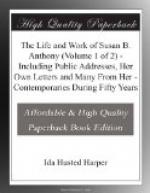A letter written by Mrs. Stanton to Martha Wright is a sample of hundreds which were sent to friends in all parts of the country:
I enclose you the proof of the memorial which Susan and I have just been getting up for Congress. I have been writing to Mr. Garrison to make some mention of us, “the only disfranchised class now remaining,” in his last Liberator. It is fitting that we should be recognized in his valedictory. We have now boosted the negro over our own heads, and we had better begin to remember that self-preservation is the first law of nature. Will you see if you can get our petition in your city and county papers? Sign it yourself and send it to your representatives in Senate and Congress, and then try to galvanize the women of your district into life. Some say: “Be still; wait; this is the negro’s hour.” We believe this is the hour for everybody to do the best thing for reconstruction.
Miss Anthony found the leaders among the men so absorbed with their interest in the male negro that they had given little thought to the suffrage as related to women; but the Hovey Committee appropriated $500 to begin the petition work. She went to Concord and held a parlor meeting attended by Emerson, Alcott, Sanborn and other sages of that intellectual center, stating what the women desired to accomplish. After she finished, Emerson was appealed to for an opinion but said: “Ask my wife. I can philosophize, but I always look to her to decide for me in practical matters.” Mrs. Emerson replied without hesitation that she fully agreed with Miss Anthony in regard to the necessity for petitioning Congress at once to enfranchise women, either before this great body of negroes was invested with the ballot or at the same time. Mr. Emerson and the other gentlemen then assured her of their sympathy and support.
[Autograph: R. Waldo Emerson]
She presented her claims at the annual anti-slavery meeting in Westchester and at many other gatherings. She went also to Philadelphia to visit James and Lucretia Mott and interest Mary Grew and Sarah Pugh and all the friends in that locality; then back to New York with tireless energy and unflagging zeal. She wrote articles for the Anti-Slavery Standard, sent out petitions and left no stone unturned to accomplish her purpose. The diary shows the days to have been well filled:
Went to Tilton’s office to express regrets at not being able to attend their tin wedding. He read us his editorial on Seward and Beecher. Splendid!... Went to hear Beecher, morning and evening. There is no one like him.... Spent the day at Mrs. Tilton’s and went with her to Mrs. Bowen’s.... Listened to O.B. Frothingham, “Justice the Mother of Wisdom."... Put some new buttons on my cloak. This is its third winter.... Excellent audience in Friends’ meeting house, at Milton-on-the-Hudson. Visited the grave of Eliza W. Farnham.... Went over to New Jersey to confer with Lucy Stone




